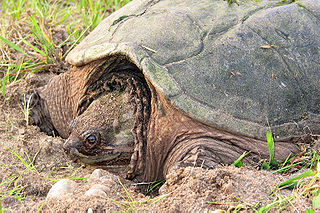
Tortoises are reptiles of the family Testudinidae of the order Testudines. Like other turtles, tortoises have a shell to protect from predation and other threats. The shell in tortoises is generally hard, and like other members of the suborder Cryptodira, they retract their necks and heads directly backward into the shell to protect them.

Giant tortoises are any of several species of various large land tortoises, which include a number of extinct species, as well as two extant species with multiple subspecies formerly common on the islands of the western Indian Ocean and on the Galápagos Islands.

The Bolson tortoise, also called the Mexican giant tortoise or yellow-margined tortoise, is a species of tortoise from North America. Of the six North American tortoise species, it is the largest, having a carapace length of about 46 cm (18 in). It lives in a region of the Chihuahuan Desert known as the Bolsón de Mapimí, which is located in north-central Mexico.

The Aldabra giant tortoise is a species of tortoise in the family Testudinidae. The species is endemic to the Seychelles, with the nominate subspecies, A. g. gigantea native to Aldabra atoll. It is one of the largest tortoises in the world. Historically, giant tortoises were found on many of the western Indian Ocean islands, as well as Madagascar, and the fossil record indicates giant tortoises once occurred on every continent and many islands with the exception of Australia and Antarctica.

Chelydra is one of the two extant genera of the snapping turtle family, Chelydridae, the other being Macrochelys, the much larger alligator snapping turtle. The snapping turtles are native to the Americas, with Chelydra having three species, one in North America and two in Central America, one of which is also found in northwestern South America.

Aldabrachelys is genus of giant tortoises, including the Aldabra giant tortoise native to the Seychelles, as well as two extinct species, Aldabrachelys abrupta and Aldabrachelys grandidieri known from Madagascar.

The Reunion giant tortoise is an extinct species of giant tortoise in the family Testudinidae. It was endemic to Réunion Island in the Indian Ocean.

The saddle-backed Mauritius giant tortoise is an extinct species of giant tortoise in the family Testudinidae. It was endemic to Mauritius. The last records of this tortoise date to the early 18th century.

The domed Rodrigues giant tortoise is an extinct species of giant tortoise in the family Testudinidae. It was endemic to Rodrigues. It appears to have become extinct around 1800, as a result of human exploitation.

The domed Mauritius giant tortoise is an extinct species of giant tortoise. It was endemic to Mauritius.

The saddle-backed Rodrigues giant tortoise is an extinct species of giant tortoise in the family Testudinidae. The species was endemic to Rodrigues. Human exploitation caused the extinction of this species around 1800.

The black-breasted leaf turtle, also commonly called the Vietnamese leaf turtle or the black-breasted hill turtle, is a species of turtle in the family Geoemydidae. The species is endemic to Southeast Asia.

The flat-backed spider tortoise, more commonly known as the flat-tailed tortoise, and Madagascan flat-tailed tortoise, is a tortoise that belongs to the family Testudinidae. The various common names for this small tortoise usually refer to the noticeably flattened nature of its oblong upper-shell or its tail.

Chelonoidis is a genus of turtles in the tortoise family erected by Leopold Fitzinger in 1835. They are found in South America and the Galápagos Islands, and formerly had a wide distribution in the West Indies.

Aldabrachelys grandidieri, or Grandidier's giant tortoise, is an extinct species of tortoise that was endemic to Madagascar. Mitochondrial DNA extracted from subfossil bone confirm that it is a distinct species.

The Tenerife giant tortoise is an extinct species of cryptodire turtle in the family Testudinidae endemic to the island of Tenerife, in the Canary Islands.
The Gran Canaria giant tortoise is an extinct species of cryptodire turtle in the family Testudinidae endemic to the island of Gran Canaria, in the Canary Islands.
Giant tortoises are any of various large land tortoises
Chelonoidis alburyorum is an extinct species of giant tortoise that lived in the Lucayan Archipelago from the Late Pleistocene to around 1400 CE. The species was discovered and described by Richard Franz and Shelley E. Franz, the findings being published in 2009.
Astrochelys rogerbouri is an extinct tortoise species in the family Testudinidae which formerly lived in Madagascar.

















